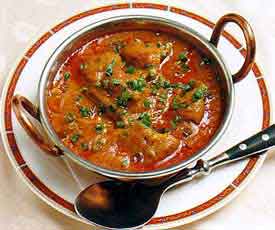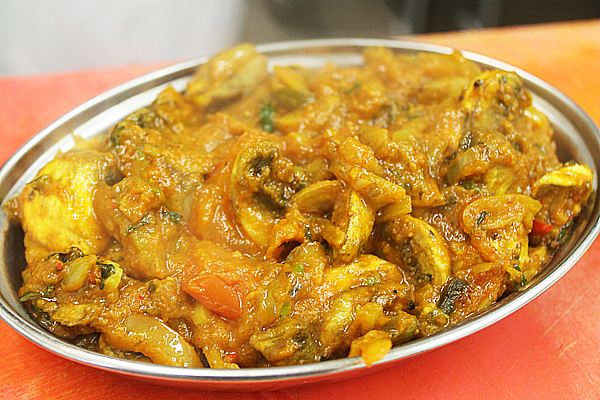Vegetable Curry Recipes Biography
Source(google.com.pk)
Green gram dal is a very mild dal which goes well with pretty much any vegatables or greens. This dal is used a lot in kerala food and hence in kanyakumari food which happens to be my native. Ofcourse any other dal can be used but the taste varies. This dal is my favorite and it goes well with plain rice or chappatti. The following recipe can be used with any other greens to get Spinach Dal, Collard Greens Dal, Turnip greens Dal, Methi dal, Radish greens dal, swiss chard dal, kale dal, methi dal (vendaya keerai) etc. I've tried with most of the greens and it all tastes good.
Ingredients
Mustard greens - 1 bunch (finely chopped)
Green gram (Moong) Dal - 1 cup
Onion - 1(finely diced)
Garlic - 2 cloves (finely minced)
Tomato - 1/2 (finely diced)
Turmeric powder - 1/4 tsp
Asafoetida powder - 1/4 tsp
Mustard - 1/4 tsp
Cumin seeds - 1/4 tsp
Dry red chilly - 2
Curry leaves - 5 leaves
Salt - to taste
Oil - 4 tsp
Grated coconut - 2 tblsp
Method
1.Heat oil in a deep sauce pan and splutter mustard, dry red chillies and curry leaves.
2.Fry the onions and garlic until they begin to sweat.
3.Now add the green gram (moong) dal, chopped tomatoes, turmeric powder, asafoetida powder, little salt and water.Cover and cook for 15 minutes.
4.In the meantime grind the grated coconut and cumin seeds to form a coarse paste and keep aside.
5.When the dal is half cooked, add the chopped mustard greens and cook for another 15 minutes or until the leaf becomes tender. Add more water as needed.
6.At this stage add the coconut paste, mix everything together and switch off.
Ingredients
Moong Dal (Split yellow lentils) - 1 cup
Turmeric Powder - 1/4 tsp
Garlic - 1 clove
Salt - to taste
To grind
Grated Coconut - 1/4 cup (you can add more if you prefer)
Cumin Seeds - 1 tsp
Green Chillies - 2 or 3
For Seasoning
Coconut oil - 1 tblsp
Mustard Seeds - 1/4 tsp
Shallots - 3 (sliced)
Dried Red Chilly - 1
Curry Leaves - 1 spring
Method
Take a pressure cooker or a heavy bottomed pan and dry roast the dal till you get a nice aroma.
Add 3-4 cups of water, garlic clove, salt and turmeric powder to the dal. Pressure cook or cook on open pot till the dal is soft and mashy.
In the meanwhile, grind together the grated coconut, cumin seeds and green chillies with required water.
Once the dal is cooked, add this ground paste and cook for another 5 minutes. (Some people like to mash up the dal at this stage. Its really upto you.)
While the dal is simmering, heat a small pan in another stove. Add oil and pop the mustard seeds. Add the sliced shallots and fry till golden brown. Add the curry leaves and dry red chilly and switch off.
Add this tempering on the dal and switch off.
Serving Suggestions
Serve this parippu curry with steamed rice, a drizzle of homemade ghee on top and some papadam. This is comfort food for most Keralites.
Ofcourse you can also have this dal with roti.
Serves : 4
Bachelor Tips
All bachelors or forced bachelors who do not have a mixie or blender can also enjoy this dish. You can add coconut powder, cumin powder and white chilly powder (or chopped green chillies) to the dal instead of making a paste.
The variations in sambhar depends on the vegetable/combination of vegetables used. The common types of sambhar that are made are onion sambhar, murungakkai (drumstick) sambhar, mulangi (radish) samhar, manga (raw mango) sambhar, vendakka (ladies finger) sambhar, Potato Sambhar, Masoor Dal Sambhar, Pasi paruppu (Green gram dal) sambhar etc.
Ingredients
Pigeon Peas (Toor dal) - 3/4 cup (You can also use masoor dal or green gram dal or a combination of dals)
Vegetables (any choice of a single/mixed vegetables) - 1 cup (The choice of vegetables can include brinjal, potato, radish, drumstick, spinach, shallot onions, tomato, raw mango, carrot, zucchini, yellowsquash, lima beans, pumpkin, yam, taroroot, okra, knolkhol etc)
Shallot Onions - 8- 10 (or 1 onion chopped)
Green Chilly - 1 or 2
Tomatoes - 1
Tamarind Juice - 1 1/2 tblsp
Sambhar powder (store bought or home made) - 1 tblsp (you can increase to your taste)
Mustard seeds - 1/4 tsp
Cumin seeds - 1/4 tsp
Fenugreek seeds - 5-7 seeds
Dry red Chillies - 2
Curry leaves - 2 strands
Cilantro - for garnish
Method
Boil the toor dal with the tomato, 2.5 cups of water and optionally 2 cloves of garlic. You can cook it using the pressure cooke for 3 whistles. Alternatively cook it in a normal vessel till it is a bit overcooked and is almost mashed up.
After the pressure is released, mash the dal using the back of a spoon or with hand.
Heat oil in a deep vessel and splutter the mustard seeds, cumin seeds, fenugreek seeds, dry red chillies, curry leaves and asafoetida.
Saute the onions and green chillies.
Add the veggies to this and cook it till the veggies are soft with enough water.(Alternatively you can cook the vegetables using a microwave and add it. You can also cook the vaggies along with the dal in the cooker itself. If you have a double decker pressure cooker container, you can cook the dal in one and the veggies in the other.)
After the veggies are cooked, add the tamarind juice, salt, sambhar powder and the mashed dal.
Add enough water and bring it to a boil. Reduce the flame and simmer for 20 minutes for the flavours to blend. A nice aroma of sambhar will be filled throughout the house.
Garnish with finely chopped cilantro and switch off.
Serving Suggestion
Hot sambar is best to be served with hot rice, idlis or dosa varieties.
You can add a tsp of ghee on the sambhar while serving to enhance the flavour.
Tips
You can add little coconut milk/grated coconut while cooking the sambhar for a nice taste.
You can also make masoor dal sambhar, green gram (pasi paruppu) sambhar too.
You can also skip the tamarind and add 2-3 additional tomatoes to make sambhar. Usually this is done for making idli sambhar.
Some people like to add a spoonful of sugar or jaggery to the sambhar.
When you make the sambhar with home made spice mix (sambhar powder), it is called arachu vitta sambhar.
Sprouts are one of the popular protein packed food that have been part of Indian cuisine for many years. More than eating the grains by itself, sprouting them improves its nutritional value considerably. The protein content, fiber content and vitamin content increases drastically when a grain sprouts. I have already shared the recipe for Sprouts Salad which can be made with fresh sprouts. In case if your sprouts have been for a couple of days, it is better to cook it and consume them. This will prevent from food poisoning. Here I have shared a curry made with homemade mung sprouts. It tastes excellent with chapatti and with white rice.
Ingredients
Green gram dal sprouts - 1 cup
Onion - 1
Garlic - 2 cloves
Tomato - 2
Chilly powder - 2 tsp
Corriander powder - 2 tsp
Turmeric powder - 1/4 tsp
Coconut milk - 1/4 cup
Salt - to taste
Oil - 1 tblsp
Mustard seeds - 1/4 tsp
Curry leaves - 6-7
Cilantro - for garnish
Method
Heat oil in a pan, splatter the mustard seeds and curry leaves.
Add the onions and garlic and saute it till the onions sweat.
Add the sprouts and fry it for 2 minutes.
Make a puree of the tomato and add it at this stage along with chilly powder, coriander powder, turmeric powder and salt.
Let this cook for another 2-3 minutes until the tomato paste and the masala is nicely cooked. Sprinkle few drops of water to avoid the masala from sticking to the vessel.
Add the coconut milk and required water and let it simmer for 5- 10 minutes.
Garnish with cilantro and serve with rice or roti.
Tips
Health conscious people can skip the coconut milk.
Small onions taste better than big onions.
Vegetable Curry Recipes

Vegetable Curry Recipes

Vegetable Curry Recipes

Vegetable Curry Recipes

Vegetable Curry Recipes

Vegetable Curry Recipes

Vegetable Curry Recipes

Vegetable Curry Recipes

Vegetable Curry Recipes

Vegetable Curry Recipes

Vegetable Curry Recipes

Vegetable Curry Recipes

Vegetable Curry Recipes

Vegetable Curry Recipes

No comments:
Post a Comment